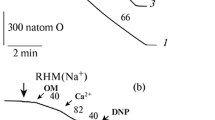Abstract
Intracellular pH affects the contractile function of the heart, metabolic reactions, ion exchange and calcium homoeostasis. Numerous studies have concluded that a fall of extracellular pH, by whatever mechanism, causes a fall of contractility by alteration of intracellular pH. Measurement of cytosolic intracellular pH using microelectrodes has confirmed that earlier deduction. Acidosis reduces the slow calcium current and the release of calcium from the sarcoplasmic reticumul but, because the cytosolic calcium does not fall, the major site of action of hydrogen ions appears to be on the calcium sensitivity of the contractile proteins. In man acidosis can be detected 15 s after the occlusion of a coronary artery and is a major mechanism for the simultaneous loss of contractility in ischaemia. A transient alkalosis is not detected in man but has been reported in isolated heart preparations where ATP consumption is low.
An imposed mild respiratory acidosis during hypoxia increases the subsequent recovery of mechanical function on reoxygenation whereas a severe acidosis can be harmful. Acidosis in ischaemic may be advantageous due to a cardioplegic effect, inhibition of transsarcolemmal calcium fluxes or a reduction of mitochondrial calcium overload. Calcium uptake on reperfusion or reoxygenation has been linked to an inward movement of sodium in exchange for hydrogen ions on reperfusion and subsequent sodium-calcium exchange. Such a mechanism in its simplest form cannot account for the similar uptake of calcium on reoxygenation and reperfusion. Acidosis is a cause of early contractile failure in ischaemia but the role of acidosis in causing cell necrosis is not established.
Similar content being viewed by others
References
Gaskell WH: On the tonicity of the heart and blood vessels. J Physiol 3: 48–75, 1980
Tennant R: Factors concerned in the arrest of contraction in an ischaemic myocardial area. Am J Physiol 113: 677–682, 1935
Poole-Wilson PA: Measurement of myocardial intracellular pH in pathological states. J Mol Cell Cardiol 6: 511–526, 1978
Poole-Wilson PA, Fleetwood G, Cobbe SM: Early contractile failure in myocardial ischaemia — role of acidosis. In: Myocardial ischaemia and Protection. Ed. Refsum H, Jynge P, Mjos OD. Churchill Livingston: Edinburgh 1983, pp 9–17
Jacobs MH: The production of intracellular acidity by neutral and alkaline solutions containing carbon dioxide. Am J Physiol 53: 457–463, 1920
Smith HW: The action of acid on turtle heart muscle with reference to the penetration of anions. Am J Physiol 76: 11–47, 1926
Poole-Wilson PA, Langer GA: Effect of pH on ionic exchange and function in rat and rabbit myocardium. Am J Physiol 229: 570–581, 1975
Poole-Wilson PA, Seabrooke SR: Relationship between intracellular pH and contractility in guinea-pig papillary muscle. J Physiol 365: 63P, 1985
Cobbe SM, Poole-Wilson PA: The time of onset and severity of acidosis in myocardial ischaemia: J Mol Cell Cardiol 12: 745–760, 1980
Cobbe SM, Parker DJ, Poole-Wilson PA: Tissue and coronary venous pH in ischaemic canine myocardium. Clin Cardiol 5: 153–156, 1982
Couper GS, Weiss J, Hiltbrand B, Shine KI: Extracellular pH and tension during ischaemia in the isolated rabbit ventricle. Am J Physiol 247: 11916–11927, 1984
Jacobus WE, Pores IH, Lucas SK, Clayton HK, Weisfeldt ML, Flaherty JT: The role of intracellular pH in the control of normal and ischaemic myocardial contractility. In: Intracellular pH Ed: R Nuccitelli, DW Deamer. Alanliss: New York 1982 pp 537–565
Allen DG, Morris PG, Orchard CH, Pirolo JS: A nuclear magnetic resonance study of metabolism in the ferret heart during hypoxia and inhibition of glycolysis. J Physiol 361: 185–204, 1985
Gebert G, Benzing H, Strohm M: Changes in the interstitial pH of dog myocardium in response to local ischaemia, hypoxia, hyper- and hypo-capnia, measured continuously by means of glass microelectrodes. Pflugers Archiv 339: 72–81, 1971
Crake T, Crean P, Shapiro LM, Rickards AF, Poole-Wilson PA: Acidosis in heart muscle after acute coronary occlusion in man: studies during angioplasty. Br Heart J 57: 77, 1987
Cobbe SM, Poole-Wilson PA: Continuous coronary sinus and arterial pH monitoring during pacing induced ischaemia in coronary artery disease. Br Heart J 47: 369–374, 1982
Crake T, Crean P, Shapiro L, Canepa-Anson RC, Poole-Wilson PA: Continuous recording of coronary sinus oxygen saturation during atrial pacing in patients with coronary artery disease or with syndrome X. Br Heart J 59: 31–38, 1988
Serruys PW, Wijns W, Van den Brond M, Meij S, Slager C, Schuubiers JCH, Hugenholtz PG, Brower RW: Left ventricular performance, regional blood flow, wall motion and lactate metabolism during transluminal angioplasty. Circulation 70: 25–36, 1984
Donaldson RM, Taggert P, Bennett JG, Rickards AF: Study of electrophysiological ischaemic events during coronary angioplasty. Tex Heart Inst J 11: 23–30, 1984
Webb SC, Rickards AF, Poole-Wilson PA: Coronary sinus potassium concentration recorded during coronary angioplasty. Br Heart J 50: 146–148, 1983
Webb SC, Poole-Wilson PA: Potassium exchange in the human heart during atrial pacing and myocardial ischaemia. Br Heart J 290: 1961–1865, 1985
Noma A: ATP — regulated K+ channels in cardiac muscle. Nature 305: 147–148, 1983
Gaspardone A, Shine KI, Seabrooke SR, Poole-Wilson PA: Potassium loss from rabbit myocardium during hypoxia; evidence for passive efflux linked to anion extrusion. J Mol Cell Cardiol 18: 389–399, 1986
Crake T, Kirby MS, Poole-Wilson PA: Potassium efflux from the myocardium during hypoxia: role of lactate ions. Cardiov Res 21: 886–891, 1986
Lakatta EG, Nayler WG, Poole-Wilson PA: Calcium overload and mechanical function in posthypoxic myocardium: biphasic effect of pH during hypoxia. Eur J Cardiol 10: 77–87, 1979
Lazdunski M, Frelin C, Vigne P: The sodium/hydrogen exchange system in cardiac cells: its biochemical and pharmacological properties and its role in regulating internal concentrations of sodium and internal pH. J Mol Cell Cardiol 17: 1029–1042, 1985
Poole-Wilson PA, Harding DP, Bourdillon PDV, Tones MA: Calcium out of control. J Mol Cell Cardiol 16: 175–187, 1984
Poole-Wilson PA: Reperfusion damage in heart muscle: still unexplained but with new clinical relevance. Clin Physiol 7: 439–453, 1987



